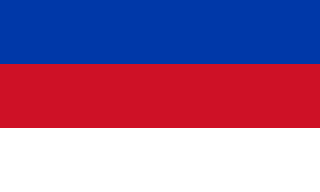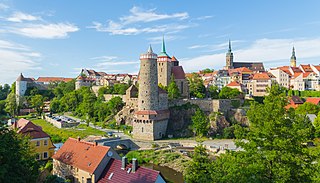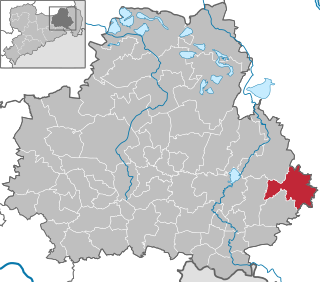
The Sorbian languages are the Upper Sorbian language and Lower Sorbian language, two closely related and partially mutually intelligible languages spoken by the Sorbs, a West Slavic ethno-cultural minority in the Lusatia region of Eastern Germany. They are classified under the West Slavic branch of the Indo-European languages and are therefore closely related to the other two West Slavic subgroups: Lechitic and Czech–Slovak. Historically, the languages have also been known as Wendish or Lusatian. Their collective ISO 639-2 code is wen.

Wends is a historical name for Slavs who inhabited present-day northeast Germany. It refers not to a homogeneous people, but to various peoples, tribes or groups depending on where and when it was used. In the modern day, communities identifying as Wendish exist in Slovenia, Austria, Lusatia, the United States, and Australia.

Sorbs are an indigenous West Slavic ethnic group predominantly inhabiting the parts of Lusatia located in the German states of Saxony and Brandenburg. Sorbs traditionally speak the Sorbian languages, which are closely related to Czech, Polish, Kashubian, Silesian, and Slovak. Upper Sorbian and Lower Sorbian are officially recognized minority languages in Germany.

Lusatia is a historical region in Central Europe, territorially split between Germany and Poland. Lusatia stretches from the Bóbr and Kwisa rivers in the east to the Pulsnitz and Black Elster rivers in the west, and is located within the German states of Saxony and Brandenburg as well as in the Polish voivodeships of Lower Silesia and Lubusz. Major rivers of Lusatia are the Spree and the Lusatian Neisse, which defines the border between Germany and Poland. The Lusatian Mountains of the Western Sudetes separate Lusatia from Bohemia in the south. Lusatia is traditionally divided into Upper Lusatia, the hilly southern part, and Lower Lusatia, the flat northern part.

Bautzen or Budyšin, until 1868 Budissin in German, is a town in eastern Saxony, Germany, and the administrative centre of the district of Bautzen. It is located on the Spree river, is the eighth most populous town in Saxony, and is the seat of Saxony's largest district. Bautzen lies in the bilingual Sorbian settlement area of Lusatia, and is Lusatia's third-largest town after Cottbus and Görlitz, as well as the second-largest town in Upper Lusatia.

Domowina is a political independent league of the Sorbian and Wendish people and umbrella organization of Sorbian societies in Lower and Upper Lusatia, Germany. It represents the interests of Sorbian people and is the continual successor of the previous Domowina League of the Lusatian Sorbs. The organization is a member of the Federal Union of European Nationalities since 1990.

John Kilian also German: Johann Kilian, Upper Sorbian: Jan Kilian, pronounced[ˈjaŋˈkʲilʲi.an] was a Lutheran pastor and leader of the colony known as the Wends of Texas.

Concordia University Texas is a private university in Austin, Texas. The university offers undergraduate, graduate, and online degrees as well as an adult degree program for part-time and returning students.

Upper Lusatia is a historical region in Germany and Poland. Along with Lower Lusatia to the north, it makes up the region of Lusatia, named after the Slavic Lusici tribe. Both parts of Lusatia are home to the West Slavic minority group of the Sorbs.

Serbin is an unincorporated community in southwestern Lee County, Texas, United States. Located about 50 miles (80 km) east of Austin, it was originally established as Low Pin Oak Settlement by Sorbian (Wendish) immigrants to Texas in the mid-1850s. The community's name was changed to Serbin, meaning "Sorbian land" in the Sorbian language, prior to 1860. The West Slavic Sorbs are distinct from the South Slavic Serbs, although the names of the two Slavic ethnic groups have a common origin.

Weißenberg (German) or Wóspork is a town in the district of Bautzen, in Saxony, Germany. The Upper Lusatian town has approximately 3100 inhabitants and is part of the recognized Sorbian settlement area in Saxony.

Johann Gottfried Scheibel was a German theologian and a leader of the Old Lutherans.

Jan Arnošt Smoler was a Sorbian philologist and writer. He played a vital role in promoting the Sorbian languages in the 19th century.

Mato Kósyk was a German minister and Sorbian language poet. He was born in Werben, Prussia, emigrated from Lower Lusatia to the United States, and died at his rural home near Albion, Oklahoma.
The Giddings Deutsches Volksblatt was a trilingual German-American newspaper published in Giddings, Texas. Most of the content was in German, while many stories were in English and some short supplements were in Wendish (Sorbian), the language of Wendish settlers in that area of Texas, especially in nearby Serbin. In early years of publication, the newspaper included a Sorbian supplement. The Deutsches Volksblatt was designed to serve the German Texan community and especially the Wends scattered throughout Texas.
Sorbian literature refers to the literature written by the Western Slavic people of Central Europe called the Sorbs in Sorbian languages.

Krystijan Bogumił Šwjela was a Wendish/Sorbian Protestant clergyman and ethnic activist in the Lower Lusatia region.

Marja Kubašec was a Sorbian writer who is considered by literary historians to be the first woman to write novels in Upper Sorbian. Working as a schoolteacher, she wrote theatre plays, short stories, biographies, and novels dealing with the history of the Sorbian people.

The Sorbian settlement area commonly makes reference to the area in the east of Saxony and the South of Brandenburg in which the West Slavic people of the Sorbs live autochthonously. In colloquial German, it is called Sorbenland ; before 1945 also – sometimes pejoratively – called Wendei.
Maćica Serbska is a scientific association of Sorbs. It aims at promoting Sorbian studies and disseminating knowledge about the Sorbs and their culture. It is the oldest Sorbian association that is still operational. Its chair person is Anja Pohontsch since 2020.





















